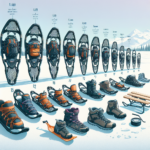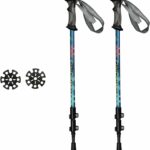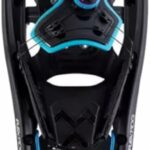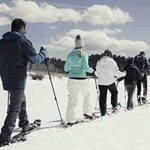If you’ve ever asked yourself, “What size snowshoes are perfect for my weight?” your search for answers ends here. In this article, you’ll discover the critical role your weight plays in choosing the ideal snowshoes. While it may seem like a minor detail, it’s crucial to remember that getting the right size can significantly affect your comfort and performance in the snow. From explaining the fundamental principles of sizing to providing a comprehensive chart, this piece will guide you in picking out the perfect pair of snowshoes for your weight.
Understanding the Importance of Your Weight in Snowshoe Selection
When planning a snowshoeing adventure, it’s important to pick the right pair. One of the lesser-known but critical factors to consider in this striking winter activity is your weight. It plays a collective role in achieving optimal performance, comfort, and safety. So, let’s dive right in to understand the importance of weight on snowshoe selection.
The crucial role snowshoes play in winter activities
Snowshoes are not a mere accessory; they are the primary equipment that allows you to travel across snow-covered terrains without sinking or struggling with each step. Think of them as extensions of your feet. They distribute your weight evenly over a larger surface area, enabling you to comfortably walk or run on the snow.
Why your weight affects the performance of snowshoes
As mentioned, snowshoes are all about weight distribution or “flotation”. The heavier you are, the more surface area you will need to float on the snow. Therefore, your weight directly impacts the size of the snowshoes you will need.
The concept of ‘flotation’ in snowshoes
Flotation is all about maintaining surface contact without sinking, for which the size (particularly the length) of the shoe plate becomes important. A poorly chosen snowshoe, not correctly proportional to your weight, may cause you to sink into the snow, making the excursion less fun and more exhausting.
Different Types of Snowshoeing and Its Impact on Shoe Size
Snowshoeing activities can broadly be classified into three categories, each necessitating different levels of flotation and hence, different snowshoe sizes.
Recreational snowshoeing
Recreational snowshoeing is mostly for beginners and includes trail walking in parks or friendly snow-covered landscapes. For such uses, medium-sized snowshoes usually suffices.
Backcountry snowshoeing
In backcountry snowshoeing, you venture into deeper, ungroomed snow and perhaps uneven terrain. Here, larger snowshoes would provide better flotation and stability.
Running or racing snowshoes
If you’re into snowshoe running or racing, smaller and lighter snowshoes are the way to go. Their compactness contributes to a better stride and speed but be mindful that they offer less flotation.
Snowshoe Size and Weight Table
Looking at a manufacturer’s size chart can get confusing, but with a little bit of exploration, you’ll start to see the correlations.
Interpreting manufacturer’s sizing chart
Manufacturers typically provide a sizing chart correlating weight ranges with snowshoe sizes. These charts are usually separated by gender and children. They may also consider gear weight, giving you all the more reason to pay attention to the specs.
Understanding the weight and snowshoe size correlation
Generally, the correlation between weight and snowshoe size is simple: the more you weigh, the larger the snowshoes you’ll need to provide that essential flotation over the snow.
Factors Affecting the Choice of Snowshoe Size
While weight is the primary factor, other variables such as terrain condition, snow condition, and your snowshoeing style can also impact the choice of snowshoe size.
Terrain condition
If you’re regularly venturing into hilly or rocky terrains, smaller snowshoes may offer better maneuverability, despite the reduced flotation.
Snow condition
Dry, fluffy snow requires more flotation than wet, compacted snow. If you snowshoe in different types of snow conditions, a medium-sized pair may offer the best compromise.
Your snowshoeing goals and style
Are you into relaxed strolls, intense hiking or competitive racing? Your purpose and style of snowshoeing can determine the size of snowshoes you’ll need.
The Impact of Body Weight on Snowshoe Size
The body’s weight is unquestionably one of the essential factors while determining the right size of the snowshoes. So, let’s decode how it works.
How does body weight affect snowshoe size?
Snowshoes work by dispersing your weight across a larger surface area, hence the term ‘flotation.’ Therefore, the more you weigh, the larger your snowshoes need to be to better distribute that weight and provide you sufficient flotation on the snow.
Choosing the correct snowshoe size based on your body weight
The correlation between body weight and snowshoe size is relatively straightforward. Most manufacturers will list out suitable weight ranges for different snowshoe sizes. This guide should be your first point of reference when choosing your snowshoes.
Including Gear Weight in Snowshoe Size Selection
Besides the bodyweight, you shouldn’t ignore the weight of the gear you intend to carry.
Assessing the weight of your winter gear
The weight of your winter gear can vary. You could be carrying as little as a fanny pack with drinks and a few snacks or as heavy as a full backpack for multi-day trips. These weight differences should reflect on your snowshoe size.
Factoring in your gear weight when choosing snowshoe size
Including your gear weight in the capacity calculation will ensure you have sufficient flotation on your snowshoeing adventures.
Sizing Differences in Men’s, Women’s, and Kid’s Snowshoes
Snowshoe sizes are customized for men, women, and kids due to the differences in their average weight and also foot size.
Sizing considerations in men’s snowshoes
Men’s snowshoes are usually wider and longer, designed to hold more weight and accommodate larger boots.
Variations in women’s and kids’ snowshoe sizing
Women’s snowshoes are typically narrower and are designed with a bit of tapering to match their stride. Kids’ snowshoes are smaller in size and made lighter for young snowshoers to handle comfortably.
Trying Out Snowshoes for the Right Fit
Just like trying on a pair of shoes before buying, all seasoned outdoor enthusiasts know the value of trying on snowshoes for the perfect fit.
The importance of trying on snowshoes before buying
Walking around in your snowshoes will give you a feel for their weight, balance, and comfort, which will genuinely reflect on your experience when out in the snow.
Feeling the fit: How should properly sized snowshoes feel?
Properly-sized snowshoes should not only accommodate your weight for adequate flotation but also be comfortable, easy to maneuver and remain stable as you move.
Common Mistakes in Choosing Snowshoe Size
Just as important as it is to know how to choose the right snowshoe size, it’s equally significant to be aware of the common mistakes made in the selection process.
Selecting snowshoes based solely on shoe size
Your shoe size is not the determinant of your correct snowshoe size. Consideration of your weight, the snow types and terrain you will be tackling, and the weight of your carried gear is critical.
Neglecting the importance of body weight in snowshoe selection
Ignoring your weight, which directly impacts the flotation of your snowshoes, tends to be a common mistake. Always consult the manufacturer’s chart correlating weight ranges with snowshoe sizes for superior performance.
Maintenance and Care of Snowshoes According to Size
With the incorrect size of snowshoes, you’re likely to put more stress on them, which could lead to early wear and tear.
The potential impact of incorrect size on snowshoe lifespan
When the snowshoes are not the right size, they don’t distribute your weight effectively, which could lead to excessive wear. Therefore, picking the right size is crucial not only for your comfort and performance but also for prolonging the life of your snowshoes.
Tips for maintaining and caring for your snowshoes
Regularly check for damage, clean the snowshoes after each use, store them in a dry place, and routinely tighten all fastenings to keep your gear in optimal condition. Remember, caring as per the size of the snowshoes ensures they are reliable companions in all your snowy treks.
- What Snowboard Bindings Should I Get? - January 23, 2024
- What Size Screws For Snowboard Bindings? - January 23, 2024
- How To Snowmobile On Water? - January 23, 2024










